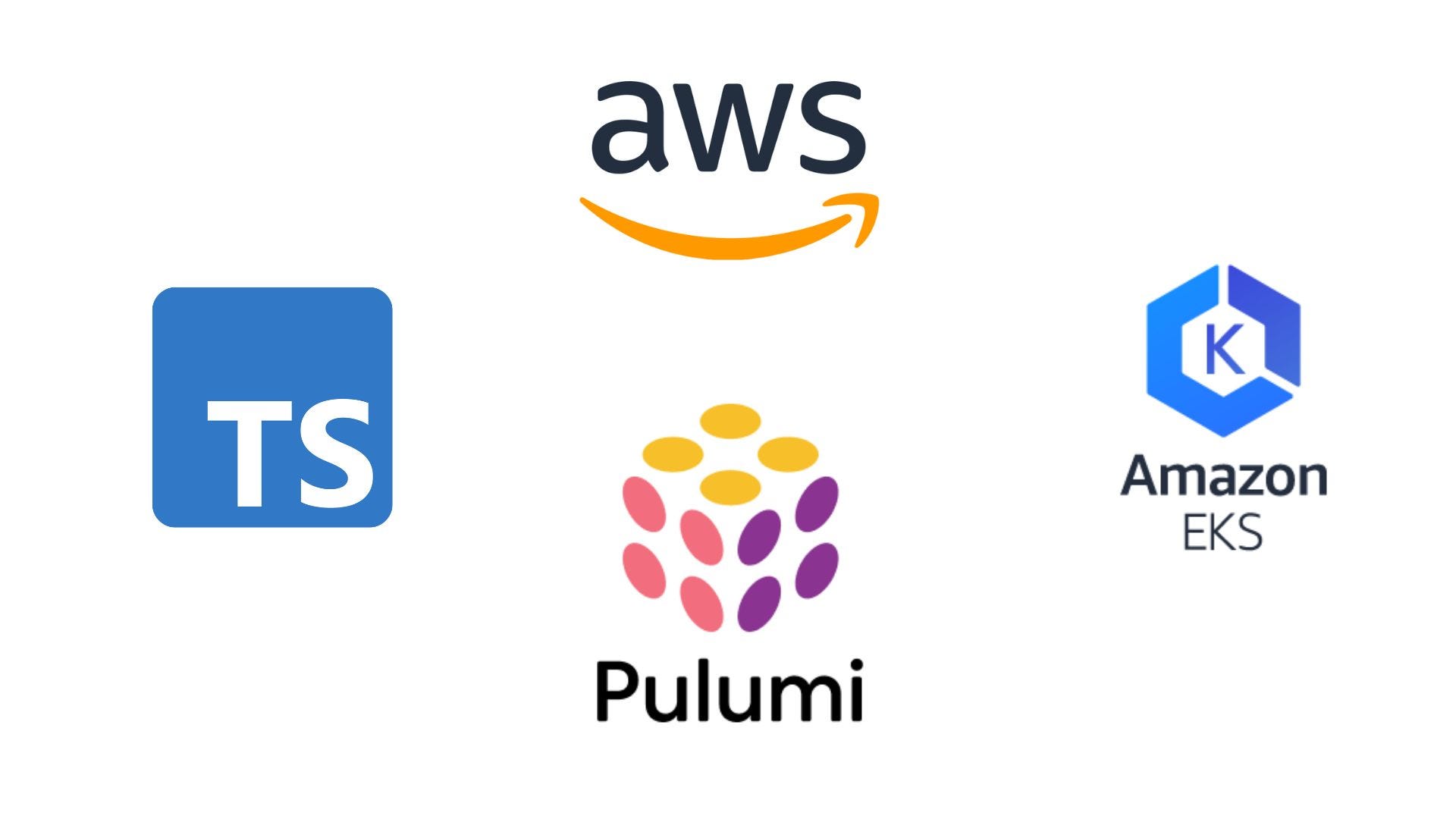Production-ready EKS cluster setup — Part III
Using the Pulumi IaC tool to provision the AWS EKS cluster

As a continuation to my blog series of Part-I, and Part-II on production-level EKS cluster setup, in this, we are going to see how to create an AWS EKS cluster using Pulumi as the IaC and Typescript as the programming language.
Pulumi is a modern Infrastructure as Code platform that allows you to use familiar programming languages and tools to build, deploy, and manage cloud infrastructure.
In a similar fashion, we will break this article into smaller parts for better understanding. Let’s dive directly into the coding part.
1. Starting with the configuration
// Grab some values from the Pulumi configuration (or use default values)
const config = new pulumi.Config();
const minClusterSize = config.getNumber("minClusterSize") || 3;
const maxClusterSize = config.getNumber("maxClusterSize") || 6;
const desiredClusterSize = config.getNumber("desiredClusterSize") || 3;
const eksNodeInstanceType = config.get("eksNodeInstanceType") || "t3.medium";
const vpcNetworkCidr = config.get("vpcNetworkCidr") || "10.0.0.0/16";
In many cases, a single project will have a different configuration based on the environments we choose to run. For example, Dev instance configs will differ from Prod instances. Such key-value pairs config can be maintained at Pulumi.
2. Creating a VPC
// Creating VPC
const eksVpc = new aws.ec2.Vpc("eks-vpc", {
tags: {
name: "my-eks-vpc",
},
cidrBlock: vpcNetworkCidr,
});
// Subnet cidr block range
const privateSubnetCidrBlock = ["10.0.1.0/24", "10.0.2.0/24", "10.0.3.0/24"];
const publicSubnetCidrBlock = [
"10.0.101.0/24",
"10.0.102.0/24",
"10.0.103.0/24",
];
// Helper function to create subnets
const createSubnetAndGetID = (
cidrRange: string,
index: number,
isPublic: boolean
) =>
new aws.ec2.Subnet(`${isPublic ? "public" : "private"}-subnet-${index}`, {
vpcId: eksVpc.id,
cidrBlock: cidrRange,
mapPublicIpOnLaunch: isPublic,
availabilityZone: index / 2 == 0 ? "us-west-2a" : "us-west-2b",
tags: {
name: "my-eks-subnets",
},
}).id;
// Create private subnet
const privateSubnet = privateSubnetCidrBlock.map((subnet, index) =>
createSubnetAndGetID(subnet, index, false)
);
// Create public subnet
const publicSubnet = publicSubnetCidrBlock.map((subnet, index) =>
createSubnetAndGetID(subnet, index, true)
);
The above code snippet will take care of the VPC cluster creation along with the private and public subnets spanned across different availability zones.
3. IAM role for EKS cluster
// IAM role for EKS cluster
const eksClusterRole = new aws.iam.Role("eks-cluster-role", {
assumeRolePolicy: JSON.stringify({
Version: "2012-10-17",
Statement: [
{
Action: "sts:AssumeRole",
Effect: "Allow",
Principal: {
Service: "eks.amazonaws.com",
},
},
],
}),
});
// Attach the AmazonEKSClusterPolicy to the role
new aws.iam.RolePolicyAttachment("cluster-role-policy-attachment", {
role: eksClusterRole.name,
policyArn: "arn:aws:iam::aws:policy/AmazonEKSClusterPolicy",
});
Creating an IAM role and associating it with the policy AmazonEKSClusterPolicy , since Kubernetes clusters managed by Amazon EKS need access to other AWS services.
4. EKS cluster
// Creating EKS cluster
const eksCluster = new aws.eks.Cluster("eks-cluster", {
roleArn: eksClusterRole.arn,
vpcConfig: {
subnetIds: [...privateSubnet, ...publicSubnet],
},
version: "1.27",
tags: {
name: "my-eks-cluster",
},
});
Creating an EKS cluster in the pre-configured subnets and attaching the eksClusterRole cluster role to it.
5. IAM role for Worker Nodes
// Create an IAM role for EKS worker nodes
const workerNodeRole = new aws.iam.Role("worker-node-role", {
assumeRolePolicy: JSON.stringify({
Version: "2012-10-17",
Statement: [
{
Action: "sts:AssumeRole",
Principal: {
Service: "ec2.amazonaws.com",
},
Effect: "Allow",
},
],
}),
});
// Attach the EKS Worker Node, CNI and container registry policy
new aws.iam.RolePolicyAttachment("worker-node-policy-attachment", {
role: workerNodeRole.name,
policyArn: "arn:aws:iam::aws:policy/AmazonEKSWorkerNodePolicy",
});
new aws.iam.RolePolicyAttachment("cni-policy-attachment", {
role: workerNodeRole.name,
policyArn: "arn:aws:iam::aws:policy/AmazonEKS_CNI_Policy",
});
new aws.iam.RolePolicyAttachment("container-registry-policy-attachment", {
role: workerNodeRole.name,
policyArn: "arn:aws:iam::aws:policy/AmazonEC2ContainerRegistryReadOnly",
});
Creating an IAM role for the worker node group and associating it with the following policiesAmazonEC2ContianerRegistryReadOnly, AmazonEKSWorkerNodePolicy, and AmazonEKS_CNI_Policy since the EC2 worker nodes need access to the EKS control plane and pull container images from the AWS registry.
6. Worker node group
// Create a Node Group
new aws.eks.NodeGroup("worker-node-group", {
clusterName: eksCluster.name,
nodeRoleArn: workerNodeRole.arn,
subnetIds: [...privateSubnet, ...publicSubnet],
scalingConfig: {
desiredSize: desiredClusterSize,
maxSize: maxClusterSize,
minSize: minClusterSize,
},
instanceTypes: [eksNodeInstanceType],
});
The above code will create the AWS-managed node group and it will take care of attaching the nodes to the EKS control plane with auto-scaling capability.
7. Exporting cluster details
// Export the cluster name, ARN and kubeconfig
export const clusterName = eksCluster.name;
export const clusterArn = eksCluster.arn;
export const clusterKubeConfig = kubeconfig;
export const vpcId = eksVpc.id;
export is used to display the outputs of your stack to the standard output.
Originally published on Medium
🌟 🌟 🌟 The source code for this blog post can be found here 🌟🌟🌟
Reference:
[1] https://www.pulumi.com/docs/clouds/aws/
[2] https://www.pulumi.com/registry/packages/aws/installation-configuration/